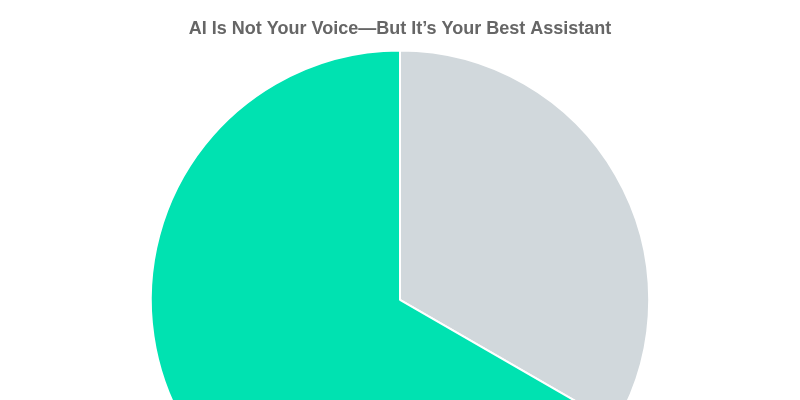Confession: I used to think you needed an audience the size of a small country (or at least a bustling city) to make real money selling digital courses. Imagine my jaw-drop when I heard about someone pocketing $12,000 with only 100 email subscribers. Cue a plot twist—turns out, you don't have to be everywhere to be profitable. In this post, we’ll wander down the winding road of launching online courses in 2025, embracing tech like AI without losing your voice, and learning just when to stick to your lane...or switch it up completely.
The Paradox of Starting Small: Big Impact with Tiny Audiences
When you think about how to sell online courses, it’s easy to get caught up in the numbers game. You see the big names with massive followings and wonder if you need thousands—or tens of thousands—of subscribers to make your first dollar. But here’s a secret that’s changing the game for course creators in 2025: you don’t need a huge audience to make a huge impact.
Forget the Numbers: Micro-Lists, Major Results
Let’s start with a true story. Imagine you have just 100 people on your email list. Not 10,000. Not even 1,000. Just 100. Most would say that’s not enough to launch anything, let alone a profitable course. But one creator did exactly that—and made $12,000 from their very first launch. That’s $120 per subscriber, right out of the gate.
What’s the secret? It’s not about the size of your audience. It’s about the relationship you have with them. When you nurture your email list—when you treat those 100 subscribers like VIPs, not just numbers—you unlock a level of trust and engagement that big lists often miss. Email marketing for course creators is still the most underappreciated tool in your arsenal. A small, engaged list will always outperform a big, cold one.
"You only need a tiny sliver of the internet for you to be profitable."
Minimalist Course Strategy: One Course, Many Launches
Here’s another myth to let go of: that you need a library of courses to build a real business. In reality, the most successful creators in 2025 are using a minimalist approach. They focus on building profitable online courses by creating one core offer, then relaunching it—smarter, not bigger—again and again.
This is the strategy Amy Porterfield, a New York Times bestselling author and top-ranked business podcaster, teaches her students. She’s generated over $120 million in revenue, but her secret isn’t endless new products. It’s refining and relaunching the same course, each time learning more about what her audience really wants. You don’t need to chase the entire internet. You just need to serve your “sliver” deeply and consistently.
Real-World Math: $1,000 Course x 10 Sales = Life-Changing
Let’s break down the numbers. If you create a course and price it at $1,000, you don’t need hundreds of sales to make a difference. Just 10 sales—that’s $10,000. For many, that’s a month’s salary, a debt paid off, or the seed money to reinvest in your business. And it’s not a fantasy; it’s happening every day for creators who focus on niche marketing for courses instead of trying to please everyone.
- Small list, big results: 100 subscribers can generate $12,000 (real data).
- Minimalist strategy: One course, launched multiple times, means less overwhelm and more profit.
- Niche focus: The more specific your course, the easier it is to sell to a tiny, passionate audience.
Niche Marketing: The 2025 Advantage
The landscape is shifting. In 2025, niche marketing for courses is more profitable than ever. Instead of casting a wide net, you go deep. You solve a specific problem for a specific group. This approach not only makes your marketing easier—it makes your course irresistible to the right people. And when you combine this with a well-nurtured email list, you create a powerful engine for sustainable, repeatable revenue.
Key Takeaways
- Don’t wait for a “big” audience. Start with who you have.
- Focus on one course and relaunch it smarter each time.
- Build and nurture your email list—it’s your most valuable asset.
- Embrace the power of niche: serve a tiny sliver, and serve them well.
Remember: you only need a tiny sliver of the internet for you to be profitable. In the world of online courses, small is not just beautiful—it’s powerful.


AI Is Not Your Voice—But It’s Your Best Assistant
Let’s be honest: AI is everywhere now. If you’re a small course creator, you’ve probably heard about Leveraging AI Content Creation with tools like ChatGPT, Perplexity, Gemini, and Claude. These platforms are changing the way we work, but there’s a crucial truth you need to hold onto: AI is not your voice—it’s your best assistant.
AI Is the New Toolkit for Course Creators
Think of AI as your digital Swiss Army knife. It’s there to help you brainstorm, organize, and personalize your content. But here’s the golden rule: never use AI for bland, copy-paste content. Your audience is looking for your unique perspective, your stories, your expertise. If you hand over your entire course to a bot, you risk becoming just another forgettable voice in a sea of sameness.
"Using AI to create your entire course is the worst decision you can make."
Instead, use AI to supercharge your workflow and save time—not to replace your thinking. The new era of digital courses is all about personalized learning experiences. People expect to interact, ask questions, and get answers that feel tailored to them. AI can help you deliver on that expectation, but only if you use it wisely.
How AI Saves You 10+ Hours Per Launch (Real Numbers)
Let’s get specific. When you’re Using AI in Course Development, the right prompts and workflows can save you at least 10 hours per course launch. Here’s how:
- Brainstorming: AI can help you flesh out ideas, organize modules, and spot gaps in your outline.
- Outlining: Generate draft structures for your course, then refine them with your expertise.
- Sales Copy: Get a solid first draft for emails, landing pages, and social posts—then inject your own voice and stories.
- Personalization: Use AI to suggest tailored resources or feedback for different student needs.
But remember: AI is a starting point, not the finish line. If you just copy and paste what AI gives you, your course will feel generic. The magic happens when you take those AI-generated drafts and layer in your unique POV.
Crafting Authenticity: The “Write Like Amy” Approach
Here’s a real-world example. In our company, we built a proprietary AI tool called “Write Like Amy”. It’s trained on years of newsletters, podcast scripts, emails, and sales pages—all written in my voice. Now, when my team needs to draft something as “me,” they use this tool as a baseline. But—and this is key—they always review, edit, and personalize the output before it goes live.
This approach keeps our brand voice consistent while saving hours on content creation. It’s a perfect example of Scaling Online Courses AI Tools without sacrificing authenticity. The AI does the heavy lifting, but the final product is always shaped by human experience and judgment.
Personalization: The Secret to Standing Out
In 2025, personalization is no longer a nice-to-have—it’s expected. Your students want to feel seen and heard. AI can help you deliver personalized feedback, recommend resources, and even support your coaches with internal tools. For example, we use AI to help coaches review student work more efficiently, so they can focus on the nuances that make a difference.
But here’s the risk: AI can dilute your unique POV if you’re not careful. The more you rely on generic outputs, the more you blend into the background. That’s why your leadership matters. As the founder, you need to be hands-on—experimenting, training your team, and setting the standard for how AI is used in your brand.
Choosing the Right AI Tools for Course Creation
We’ve tested multiple platforms—ChatGPT, Claude, and custom GPTs for everything from podcast titles to interview questions. Our advice? Pick one platform and master it before moving on. For us, ChatGPT is the go-to for daily workflows, but the real value comes from building custom tools that reflect your brand’s voice and values.
Ultimately, Leveraging AI Content Creation is about working smarter, not replacing your creativity. Use AI to save time, scale your impact, and deliver personalized learning experiences—but never let it drown out what makes you, you.

The Make-or-Break Factor: POV Over Perfection
In the fast-evolving world of online course trends in 2025, there’s one thing that separates the truly successful from the sea of sameness: your Point of View (POV). As a small course creator, you might look at the explosion of AI-generated content and feel overwhelmed. After all, anyone can now access solid information at lightning speed. But here’s the truth: AI can’t replicate your story, your beliefs, or your lived experience. Your POV is your unfair advantage—the secret sauce that makes you memorable, referable, and, ultimately, indispensable.
Think about the names that come up when people talk about digital course creation strategies or brand evolution content creators. They aren’t just experts—they’re people with a clear, consistent message. They’ve become the go-to voices in their niches, not because they chased every trend, but because they owned their perspective and repeated it until it became synonymous with their name. That’s the power of POV over perfection.
Here’s the part most creators miss: getting bored is part of the process. If you’re tired of saying the same thing, it probably means your message is finally starting to stick with your audience. Amy Porterfield, a giant in the online course industry, once said,
"Even on a day I might be bored answering the same question, I'm there for it because I know what it can do for my students."She’s not exaggerating—after 16 years, over 700 podcast episodes, and $120 million in course revenue, she’s still repeating her core message. That’s not stagnation; that’s mastery. It’s how you become the person people name-drop in rooms you’ve never entered.
But what about evolution? Isn’t it important to grow and expand your brand? Absolutely—but only after you’ve earned it. The most impactful brand evolution content creators didn’t pivot on a whim. They built a foundation first, becoming known for one thing before expanding into new territory. Amy didn’t start by offering masterminds or multi-million dollar business coaching. She spent years in the trenches, helping people launch their first digital courses and sharing every lesson along the way. Only after she was recognized as the gold standard in her field did she expand her focus—and her audience was ready to grow with her.
This is the discipline most overlook. In a world obsessed with novelty, the real success stories in digital course launches come from those who stay in their lane long enough to become the obvious choice. It’s not glamorous, and yes, it can get repetitive. But that’s how you build trust, authority, and a brand that opens doors—whether it’s speaking gigs, podcast invitations, or high-ticket programs. If you want your name to be the one people mention when they talk about online course trends in 2025, you have to earn that recognition through consistency and clarity of message.
When the time comes to evolve your brand, you’ll feel it. It’s both a personal calling and a strategic move. Maybe your audience is growing with you, or you’re ready for new challenges. The key is to expand, not abandon, what you’re known for. Amy’s transition from “helping people launch courses” to “helping people build million-dollar businesses” wasn’t a leap—it was a natural next step, built on years of trust and results. She didn’t pivot because she was bored; she pivoted because she was ready, and so was her community.
So, as you navigate your journey as a small course creator in 2025, remember: Perfection is overrated. POV is everything. Your beliefs, stories, and experiences are what set you apart in a world of algorithm-driven sameness. Stay consistent, own your message, and don’t rush the process. When you’re ready to evolve, your audience will be ready to follow. That’s how you build a brand that lasts—and that’s the real make-or-break factor in digital course creation today.
TL;DR: The best digital course creators in 2025 combine authentic personal branding with AI-powered personalization, focusing on strong niche expertise and then evolving strategically. You don't need a huge audience, but you do need a clear POV—and the humility to reinvent yourself when the time is right.



